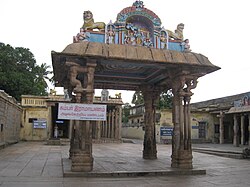This article needs additional citations for verification .(February 2018) |
| Part of a series on |
| Hindu scriptures and texts |
|---|
 |
| Related Hindu texts |


The Ramavataram, popularly referred to as Kamba Ramayanam, is a Tamil epic that was written by the Tamil poet Kambar during the 12th century. Based on Valmiki's Ramayana (which is in Sanskrit), the story describes the legend of King Rama of Ayodhya. However, the Ramavataram is different from the Sanskrit version in many aspects – both in spiritual concepts and in the specifics of the storyline. [1] [2] This historic work is considered by both Tamil scholars and the general public as one of the greatest literary works in Tamil literature. [3]
Contents
- Early references in Tamil literature
- Structure
- Compilation
- Literary significance
- Religious significance
- Translations
- Musical adaptations
- See also
- References
- External links
| Ramavataram | |
|---|---|
| Information | |
| Religion | Hinduism |
| Author | Kambar |
| Language | Tamil language |
| Period | 12th century |
| Chapters | 6 kandams (original) + 1 later addition |
Kambar wrote this epic with the patronage of Thiruvennai Nallur Sadayappa Vallal, a chieftain of the Pannai lineage. [4] In gratitude to his patron, Kamban references his name once in every 1,000 verses.

